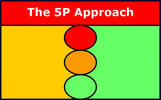The 5P Approach Flexibility Assessment
Use the 5P Approach Flexibility Assessment:-
As with other areas characteristic to autism, although flexibility is an area of "difference" shared by all individuals with autism spectrum disorder, not all of them have the same degree of difference or range of problems. Following the 5P process, firstly we need to assess exactly what skills the individual already has and those which s/he could begin to develop. Establishing a method of flexibility assessment is therefore an essential first step.
Over the years, working with families and schools, Linda developed the 5P Approach Flexibility Assessment and its accompanying recording materials. These can be found in more detail in Developing Flexibility Skills in Children and Teens with Autism - the 5P Approach to Thinking, Learning and Behaviour and include:
The Flexibility Continuum
In tracking the development of flexibility skills, we need to see flexible thinking skills as being part of a Flexibility Continuum. As the individual develops skills, they increase their degree of flexibility. The 5P Approach Flexibility Continuum plots the development of flexible thinking through five levels from, at the lowest level ( Level One), a rigid and inflexible approach in behaviour and learning through to the acquisition of new skills in flexibility and a newly acquired independence in thought ( Level 5).
In order to ensure that we support the development and functional use of skills, the environment, strategies and approaches should match an individual’s level of flexibility. If we don’t do this, and for example, maintain a rigid and over structured approach to teaching when an individual has learned skills needed to work and play within a less structured environment, we could be preventing them from making progress.
The levels of the 5P Flexibility Continuum are therefore also linked to the type of approach used and provide a means of measuring levels of independence. The 5P Approach Flexibility Assessment and its accompanying target setting materials provide a means of supporting the individual to develop new flexibility skills and increase their level of independence.
You can read more about this and the unique 5P Approach to Flexibility assessment and planning tools in Developing Flexibility Skills in Children and Teens with Autism - the 5P Approach to Thinking, Learning and Behaviour. You can download a sample of these in the Resources section of this website or by clicking on the links below.
As with other areas characteristic to autism, although flexibility is an area of "difference" shared by all individuals with autism spectrum disorder, not all of them have the same degree of difference or range of problems. Following the 5P process, firstly we need to assess exactly what skills the individual already has and those which s/he could begin to develop. Establishing a method of flexibility assessment is therefore an essential first step.
Over the years, working with families and schools, Linda developed the 5P Approach Flexibility Assessment and its accompanying recording materials. These can be found in more detail in Developing Flexibility Skills in Children and Teens with Autism - the 5P Approach to Thinking, Learning and Behaviour and include:
- The 5P Approach Flexibility Assessment Summary sheet
- The 5P Approach Flexibility Skills Checklist
- The 5P Approach Individual Flexibility Continuum
- The 5P Approach Flexibility Planning sheet
- The 5P Approach Flexibility Target Planning
The Flexibility Continuum
In tracking the development of flexibility skills, we need to see flexible thinking skills as being part of a Flexibility Continuum. As the individual develops skills, they increase their degree of flexibility. The 5P Approach Flexibility Continuum plots the development of flexible thinking through five levels from, at the lowest level ( Level One), a rigid and inflexible approach in behaviour and learning through to the acquisition of new skills in flexibility and a newly acquired independence in thought ( Level 5).
In order to ensure that we support the development and functional use of skills, the environment, strategies and approaches should match an individual’s level of flexibility. If we don’t do this, and for example, maintain a rigid and over structured approach to teaching when an individual has learned skills needed to work and play within a less structured environment, we could be preventing them from making progress.
The levels of the 5P Flexibility Continuum are therefore also linked to the type of approach used and provide a means of measuring levels of independence. The 5P Approach Flexibility Assessment and its accompanying target setting materials provide a means of supporting the individual to develop new flexibility skills and increase their level of independence.
You can read more about this and the unique 5P Approach to Flexibility assessment and planning tools in Developing Flexibility Skills in Children and Teens with Autism - the 5P Approach to Thinking, Learning and Behaviour. You can download a sample of these in the Resources section of this website or by clicking on the links below.
